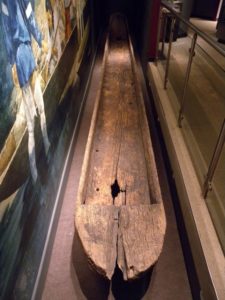During our extended closure we approached UT faculty and staff with a question. We asked them to tell us which object in our collection had the biggest impact on their classes, their students, or their own exploration within the museum.
 According to Tom Broadhead, Director of Undergraduate Academic Advancement for Undergraduate Admissions: “My all time favorite object is the large, wood canoe.” Dr. Broadhead is referring to the impressive dugout canoe on display as a part of the the Native Peoples of East Tennessee exhibition. Dr. Broadhead states, “This thing has always fascinated me by its dimension and its story. I have read about how white pioneers and explorers would sometimes find huge hollowed out tree trunks and sleep or live in them. That’s difficult to imagine, but is a cool thought.”
According to Tom Broadhead, Director of Undergraduate Academic Advancement for Undergraduate Admissions: “My all time favorite object is the large, wood canoe.” Dr. Broadhead is referring to the impressive dugout canoe on display as a part of the the Native Peoples of East Tennessee exhibition. Dr. Broadhead states, “This thing has always fascinated me by its dimension and its story. I have read about how white pioneers and explorers would sometimes find huge hollowed out tree trunks and sleep or live in them. That’s difficult to imagine, but is a cool thought.”

Canoe, Date unknown, Wood, Donated by J.B. Eldridge, 1936.1.1.
The canoe was discovered back in 1797 by Jesse Eldridge, who found it floating in the river on his land. He used the canoe in his barn as a watering trough for many years which actually helped to preserve it by protecting it from the elements.
Dr. Broadhead continues, “I love the part of the story where it was found floating, was picked up by white settlers and used as a hog trough. Talk about repurposing! And now, it’s a wonderful object that fires my imagination, every time I see it. When I am showing guests around, it is my go-to object as we walk and talk through the galleries.” The canoe is also one of our favorite pieces to show off as its incredible size and craftsmanship make it a truly extraordinary object.
The canoe often sparks lots of questions from our students and visitors, and Dr. Broadhead has some similar ones as well. “The canoe: Wow, what an incredibly long and straight (or tall) tree that must have been. I forget what kind, but I think it’s in the description. The process of burning and scraping – what must it have taken to transform a bare log into a floating craft. How many people would it hold? Was it used also to transport goods and animals?”